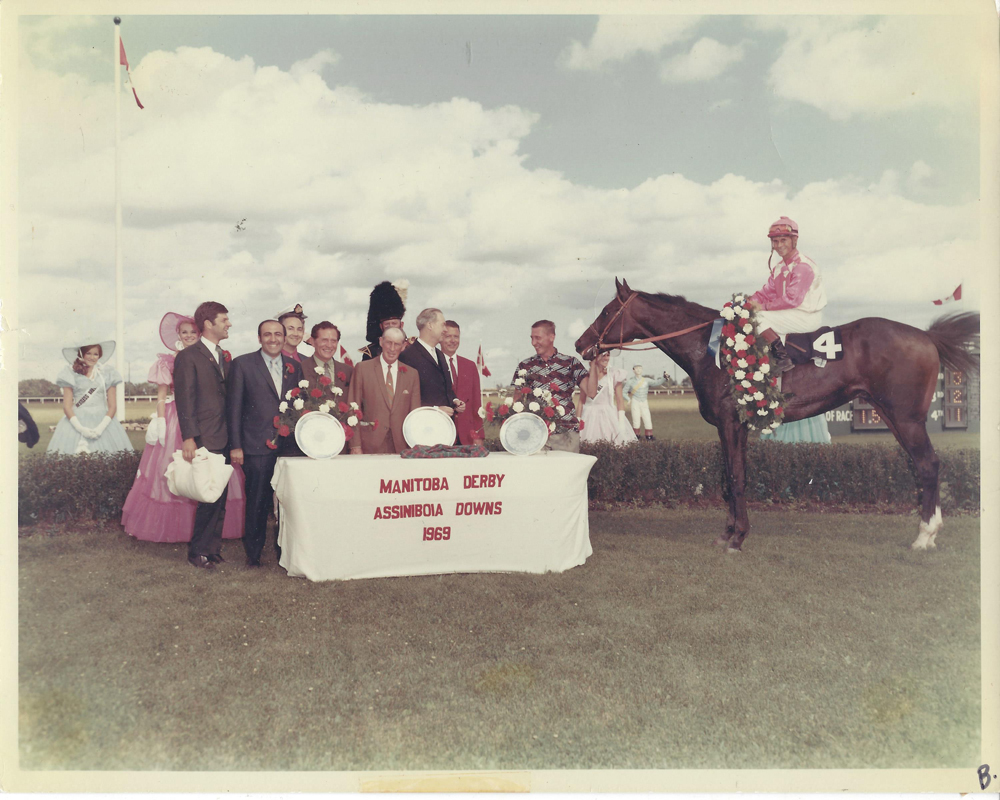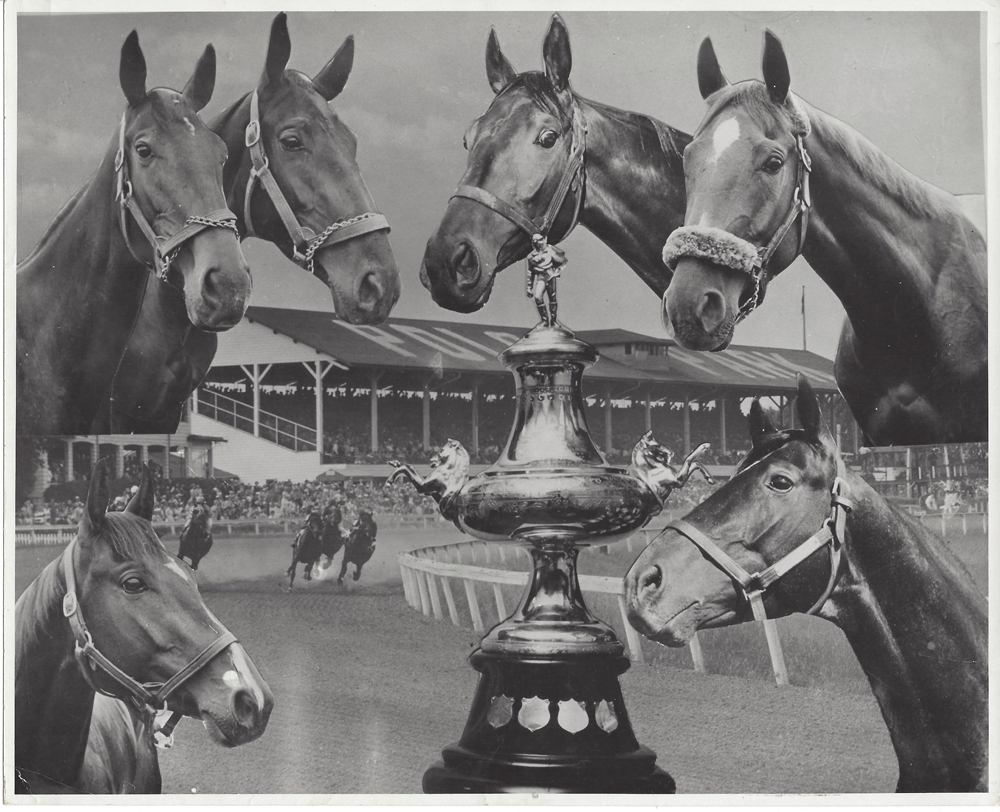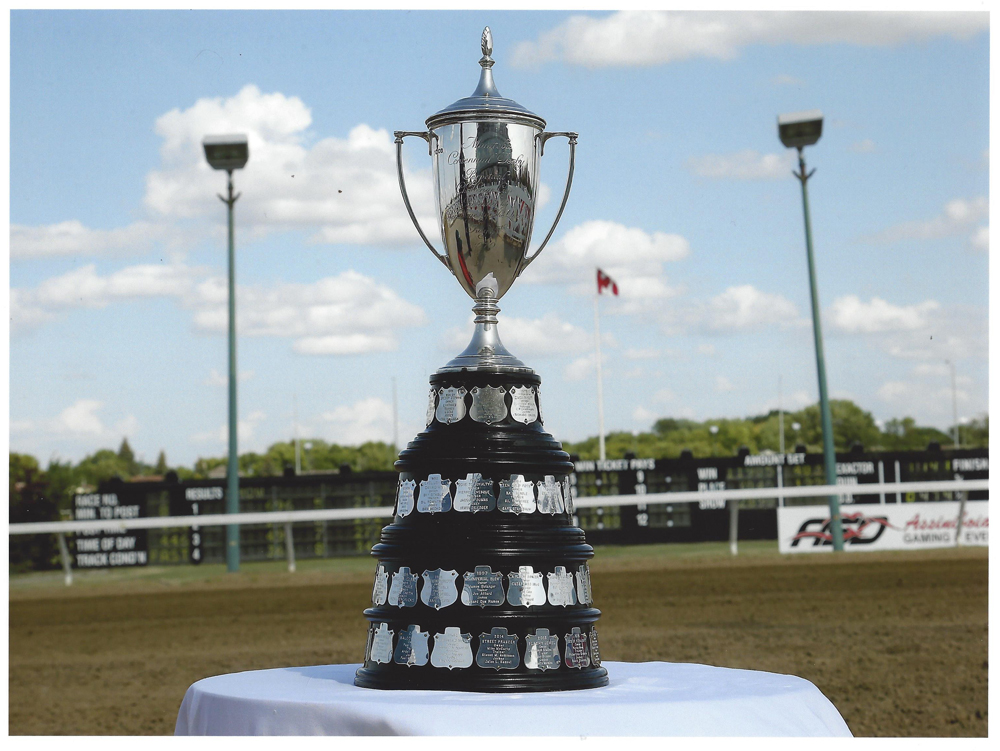
Fire n Desire. 1969 Manitoba Derby. In the special infield winner’s circle. Note the Silver Derby Trays.
by Bob Gates
Wasn’t that a Derby! A record-breaking $3,708,804 was wagered on Manitoba’s most prestigious race, making the historic 75th running of the Manitoba Derby the largest Derby Day handle, bettering last year’s mark of $3,523,260.
Congratulations to winner Mano Dura and his connections, owner, Henry Witt, Jr., trainer, Jerry Gourneau, and jockey, Antonio Whitehall. We wish them well on their quest for the 2023 Western Canadian Triple Crown $100,000 bonus.
Before putting our Derby thoughts to rest, how about a quick look at the Queen’s Cup trophy and the ceremonial Derby hardware prior to 1970. The 1970 Manitoba Centennial Derby marked the first time the Cup, donated by Her Majesty Queen Elizabeth ll, was presented for the annual competition. Including the 2023 Derby, the Queen’s Cup has been presented on 54 occasions.
Previously, the Derby winner and connections received engraved silver trays. This tradition was in place for the 10-year period from 1960, when Jack Hardy revived the Derby, until 1969. Bocage, won the first Derby held at Assiniboia Downs and the nine subsequent winners of the Derby were recipients of these Derby trays. The last silver tray winner was Fire n Desire in 1969.

The 1955 Canadian Derby featuring the Manitoba Derby Cup.
Before 1960? For this we need to go back to the first 11 years of the Derby. From 1930 to 1940 the only known trophy of significance was the “Manitoba Derby Cup.” It was presented for the first time in 1934.
The “Cup” came into the possession of Robert James Speers following the death of Dr. W. J. Hinman, who was the original winner of the trophy. It was found in a trash can behind the doctor’s livery stables. The Cup served the Manitoba Derby well from 1934 until 1940. It then became the trophy for the Canadian Derby, which had its inaugural run in 1941.
Somewhere along the way, after the last running of the Canadian Derby at Polo Park in 1956, the Cup disappeared. Did it stay in Winnipeg? Did it find its way to Edmonton with the race? We may never know.

The Queen’s Cup. Presented to the Manitoba Derby winner for 54 years.
Should anyone have any information as to its whereabouts after 1956, the history blog would love to hear from you!
We’ve past the mid-point of the 2023 season now, so how about a little racing trivia?
Who remembers Scotty Kennedy’s “37 cent” horse, Omar’s Gift? On June 8, 1942, the filly won the first race of her career and paid a tidy $15.20 for a $2 win ticket (back then it was referred to as a “straight” ticket).
However, her efforts were over shadowed that day by the results of the fourth race at Polo Park racetrack. History was made when there was a triple dead-heat for second place. It was the first ever triple dead heat recorded on Winnipeg racetracks and we don’t believe there has been another. Has there?
On June 29, 1953, a disqualification resulted in two horses winning the first race on the card at Polo Park racetrack. Race winner Arcadian Blaze failed to keep a straight course in the drive to the wire and was placed third. Turns out the two horses behind Arcadian Blaze finished in a dead-heat for second. The dead-heat duo split the first and second place share of the purse.
These days track announcers start the call of a race with the phrase “They’re Off!” This wasn’t always the case. We can’t be sure when that started, but it was likely in the late 1950s. Before then the catchphrase for the start of a race was “And There They Go!”
On June 25, 1958, Assiniboia Downs recorded its first ever dead-heat. The racetrack had only been in operation for a couple of weeks when sixth race participants Fay’s Star and Margret Anne hit the wire simultaneously in the battle for second place.
Recently we told you the story of Ten to Ace and his fabled flop in the 1942 Canadian Derby. Following his days on the track, Ten to Ace found a second career as a stud. One of his daughters, Luliang raced at the Downs in the late ‘50s and early ‘60s. And she has the distinction of winning the same race twice!
The race in question took place in Tucson. She won her race but was placed second for bearing out in the stretch drive. The race was awarded to second-place finisher, Precioso, but his saliva tests proved positive and he was disqualified. The purse was subsequently re-distributed and Luliang was put back to first place.
Who remembers when the Downs used a special winner’s circle located in the infield next to the tote board? In case you’re curious, it was first used in 1963 for the 15th running of the Manitoba Derby, but it hasn’t been used in years. The 1963 Derby winner? Calgarian “Spud” Murphy’s Brother Leo.
On July 11, 1966, jockey Tommy Laidler won the fourth race at the Downs aboard the mare Fairy Ayr, who paid a whopping $82.00 to win. The mare, owned by Ken Milne of Gladstone, Manitoba, was one of those “go big or go home” types. In 1965 Fairly Ayr only won one race and lit up the tote board, paying $126.40 for a $2 “straight” ticket.

Miss Missile wins the 2007 Debutante Stakes for trainer Charlie Smith and partner Terry Propps.This past April the Downs lost a true friend, Texan Charlie Smith. Who can forget the unbelievable Woody Stephens-type success when Charlie and his wife Terry Propps won the Debutante Stakes five years in a row from 2007 to 2011. Not to mention they narrowly missed making it six in a row in 2012 when Portales ran second. Charlie and Terry’s winners? 2007 Miss Missile, 2008 Lady Countdown, 2009 Ruby’s Big Band, 2010 Little Widow Maker and 2011 Gospel Gal.
In closing, how about these facts from the American Association of Equine Practitioners (July 21, 2021):
— Coming out of the starting gate, the horse will get to 40 miles-an-hour in six strides. A Ferrari accelerates from a standstill to 60 mph in 5.5 seconds; a horse can reach 42 mph in 2.5 seconds.
— The force on a horse’s front hoof is at its greatest at about 2,500 pounds as it hits the track. The force on its front cannon bone has an impact of 10,000-12,000 pounds.
— From rest to top speed, a horse’s heart rate increases by a factor of 10, a man’s by only four.
Did you get all that? Hope you enjoyed our historical potpourri as much as the history blog did putting it together… Now, let’s continue with the second half of season 2023.
It’s been a great year so far!
